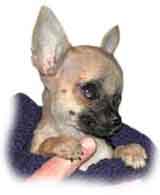Small Dog BreedsInformation About The Skye Terrier Dog Breed |
|
|
The Skye Terrier has a long and powerful body with "teddy bear" ears and a long, straight, and medium to high maintenance shedding coat, with a soft undercoat. He is a sheepdog-like breed and a curtain of hair covering his face and eyes. This is a breed that is totally devoted to his owner. He is an active, patient, and independent dog, although not as busy as other terriers. This breed is affectionate with his owners but can be moody and stubborn. He is usually reserved with strangers. This is not a dog to be pampered. He needs a firm and consistent training from puppy hood as well as extensive handling and socialization. The Skye Terrier can become passive-resistant and is quite difficult to be trained on the "Stay" and "Come" commands. He has a tendency to bite if provoked or pushed too hard. Size: The Skye Terrier stands 9-10in at the shoulder and weighs between 20-25lb. History and origin: This breed was developed in the 17 th century Scotland on the rocky Isle of Skye. He was initially used as a vermin-killer and was bred low to the ground in order to have access to tight dens and burrows of rodents. His long coat served as protection against bites of his prey. This breed evolved from the small earth dog kept in Scotland it hunt foxes, badgers, and other vermin. Although the Cairn and other breeds existed in the Highlands, it would seem that the Skye developed a unique appearance. Feeding: Recommended feeding for the Skye Terrier is 1-1 ½ cans of high quality meat product (13.3oz size) with biscuit of the same amount in volume or 3 cupfuls of complete dry food. Exercise: An apartment is suitable for this dog provided he gets plenty of exercise. He will need to be walked several times a day. Grooming: A daily brushing and once a week combing using a wide-toothed comb are required for this breed. The coat is very absorbent and will smell and mat easily if not kept dry.Back to the Small Dog Breed page
| |
|
Related News About Dogs ' ); // get rid of newsfeed display by carp CarpConf('poweredby',''); CarpCacheShow('http://www.small-dog-info.com/support-files/rss.xml'); ?>
|
|
|
|
|
|
Copyright © 2006-2007 dogguidance.com |


